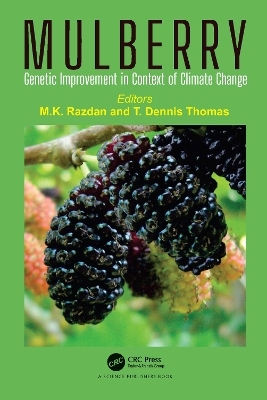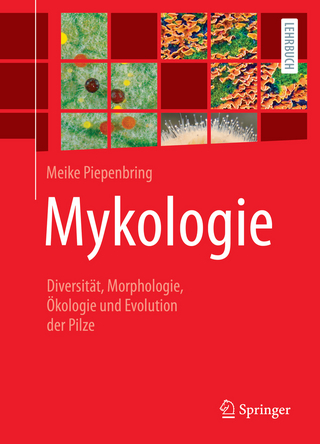
Mulberry
CRC Press (Verlag)
978-0-367-02499-4 (ISBN)
Mulberry (Morus spp.) is an important horticultural plant in the sericulture industry. It belongs to the family Moraceae. The leaf of mulberry is used to feed the silkworm Bombyx mori L. It is also used as a fodder. Due to its economic and agricultural importance, mulberry is cultivated in many parts of the world. An estimated 60% of the total cost of silk cocoon production is for production and maintenance of mulberry plants. Therefore, much attention is needed to improve the quality and quantity of mulberry leaves. It is vital to increase the production of superior quality mulberry leaves with high nutritive value for the sericulture industry.
Although a lot of research is going on in mulberry, very little effort has been made to compile the results of this research in a single book. This book provides an update of recent research works going on in this plant. It describes the taxonomy, conservation of germplasm, genetic diversity of various mulberry species, application of breeding techniques to improve the quality of mulberry, in vitro conservation, application of tissue culture techniques to improve mulberry species, production of haploids and triploids in mulberry and improvement of abiotic stress adaptive traits in mulberry with relevance to adaptiveness to global warming.
Professor (Dr.) M.K.Razdan retired as the Principal, Shyam Lal College, a constituent of University of Delhi. He has taught students for over three decades and has served as Coordinator of add-on courses on ‘Biotechnology’ and ‘Environment Management and Law’ in Delhi University. Dr. Razdan was Visiting Scientist at USDA’s Vegetable Laboratory, Beltsville Agriculture Research Centre, and later at the Department of Natural Resource Sciences and Landscape Architecture, University of Maryland, USA. Earlier in his career, he did postdoctoral research on plant cell and tissue culture in the laboratory of world known plant scientist Professor E.C.Cocking, FRS, at University of Nottingham, UK. Post-retirement Dr. Razdan served as Visiting Faculty of Life Sciences at IGNOU (Indira Gandhi National Open University), New Delhi. He has publications in reputed research journals, guided students for PhD/M Phil, refereed research papers, and has published several books with reputed publishers like Elsevier and Science Publishers. Dr. Razdan was Joint Editor and Member of the Editorial Board of the Journal of Cytology and Genetics and has had the honour of being elected as Fellow of the Society of Cytologists and Geneticists. He has been Member of Delhi University Academic Council as well as Member of Delhi University Court. He was also invited to deliver lectures at various institutes in Russia and China. Professor (Dr.) T. Dennis Thomas did his Ph.D. from Department of Botany, University of Delhi, India. He has Postdoctoral experiences from Germany, Japan and Poland. He worked as visiting Associate Professor in University of Hokkaido, Japan. He obtained DST, BOYSCAST Fellowship in 2007. He joined in Central University of Kerala, as a Professor, in Department of Plant Science in 2016. His main interest has been in the field of Plant tissue culture and reproductive biology. He has published over 65 research papers in journals of International and National repute.
SECTION A: TAXONOMY AND IMPORTANCE OF MULBERRY. Taxonomic Evaluation in Context of Mulberry. Genetic diversity in mulberry genotypes. Cultivation of Mulberry- An Important Genetic and Economic Resource. Medicinal Uses of Mulberry. Pharmacological uses of Mulberry Products. SECTION B: GENETIC IMPROVEMENT OF MULBERRY USING CONVENTIONAL AND NON-CONVENTIONAL METHODS. Sexual Hybridisation and other Breeding Procedures in Improvement of Mulberry (Morus spp.) quality and productivity of Leaf and Other Traits. Improvement of Mulberry by Induction of Polyploidy and Mutagenesis. Plant Tissue Culture in Mulberry Improvement. In vitro Production of Haploids and Triploids in Mulberry. Improvement of Mulberry (Morus spp.) by Protoplast Culture. Applications of Genetic Engineering. SECTION C: SUSTAINABLE GROWTH OF MULBERRY IN CONTEXT OF CLIMATE CHANGE. Impact of Climate change on Sustainable Growth of Morus alba. Stress Tolerant Traits in Mulberry Adaptive to Climate Change. Arbuscular Mycorrhizal Symbiosis contribute significant benefits to Growth and Quality of Mulberry Plants. Mulberry (Morus sps.) Cultivation for Sustainable Sericulture. Viroids, Viruses and Phytoplasmas of Mulberry. Conservation of Mulberry Genetic Resources to Sustain Sericulture.
| Erscheinungsdatum | 27.07.2021 |
|---|---|
| Zusatzinfo | 48 Tables, black and white; 11 Illustrations, color; 20 Illustrations, black and white |
| Verlagsort | London |
| Sprache | englisch |
| Maße | 178 x 254 mm |
| Gewicht | 640 g |
| Themenwelt | Naturwissenschaften ► Biologie ► Botanik |
| Weitere Fachgebiete ► Land- / Forstwirtschaft / Fischerei | |
| ISBN-10 | 0-367-02499-3 / 0367024993 |
| ISBN-13 | 978-0-367-02499-4 / 9780367024994 |
| Zustand | Neuware |
| Informationen gemäß Produktsicherheitsverordnung (GPSR) | |
| Haben Sie eine Frage zum Produkt? |
aus dem Bereich


